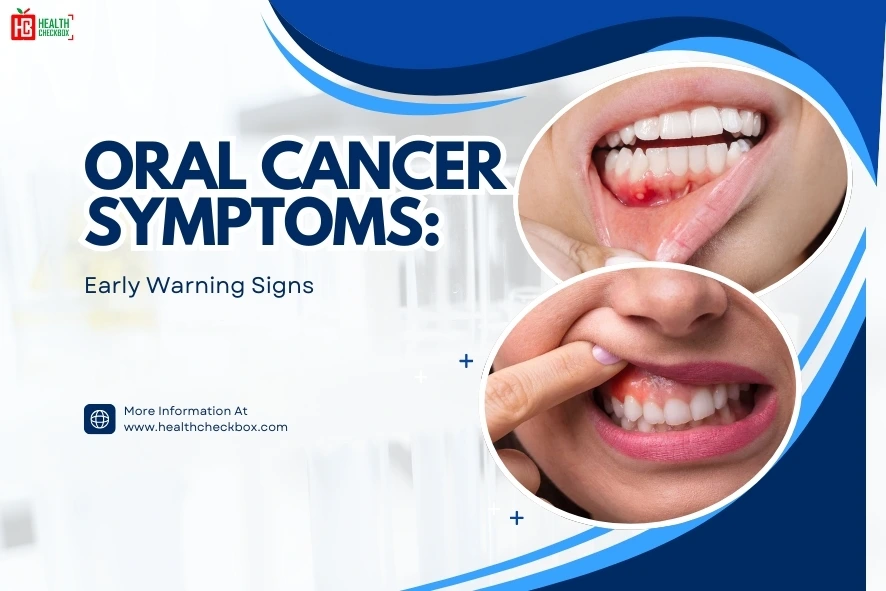When cancerous cells develop in the mouth or throat, it is known as oral cancer. It can affect any part of the mouth, including the lips, cheeks, throat, and other parts. Understanding the oral cancer symptoms is very necessary because early detection may result in easy treatment and a better cure. In this blog, we will discuss the various symptoms that can indicate the presence of oral cancer. Survival rates are high if oral cancer or any type of cancer is detected in the early phase.
What is Oral Cancer?
The following are key points that can be used to describe the true characteristics of oral cancer. This cancer belongs to the category of neck and head cancers. The throat, cheeks, gums, tongue, sinuses, and soft palate can be affected in oral cancer. Regardless of gender and age, anyone can develop this cancer. Squamous cells that line the throat and mouth, almost every cancer cell starts from here.
However, certain things increase the risk of developing this. One of the main risk factors in most cases is smoking or chewing tobacco. The risk of oral cancer is increased for sure by consuming too much alcohol. Excessive sun exposure to sensitive lips can increase the risk of lip cancer. One of the emerging risk factors is HPV infection. The risk of oral cancer developing in men is two times higher than in women. 90% cases are seen in people over 40 years old.
Early Warning Signs of Oral Cancer
There are multiple warning signs of oral cancer in its early phase:
- Sore mouth that is not healing even after three weeks.
- A patch of red colour in the mouth (erythroplakia).
- A white colour patch (leukoplakia) on the upper or lower part of the tongue, gums, or lining of the mouth.
- Sore internal cheeks that aren’t healing.
- Irritation in the mouth that remains consistent.
- The internal wall of the lips is being dried.
- Small lumps in the gum or lip.
Some of the early signs are painless, which makes them easy to ignore. Any change, whether it is painful or not, that persists for more than two weeks. Immediately seek medical attention for it.
Physical Changes in the Mouth due to Oral Cancer
There could be various changes in your mouth physically, which could be a sign of oral cancer.
- The presence of thickening or a lump inside the mouth.
- A feeling that something is stuck inside the throat.
- Bleeding in the mouth without any clear reason.
- White, red, or patches of a mix of both colours appear inside the mouth.
- A bump or lump suddenly appears inside the mouth and remains for more than 2 weeks.
- A swelling in the jaw could the another sign.
- In the neck, face, and mouth area, there could be numbness without any specific cause or reason. It could be another sign of an infection that damaged the sensory nerves.
- Swelling of the tongue and a change in the texture of the internal walls of the mouth, which is the signs of change in the texture of the tissues of the mouth.
Functional Problems Due to Mouth Cancer
There are so many functional problems if one is on the verge of oral cancer.
- Painful or difficult to move the tongue normally.
- Stiffness of the jaw and a problem in moving it smoothly.
- Facing a problem in opening your mouth properly (trismus).
- A change in speech and voice due to an internal infection.
- A cracky and weak voice that worsens with time.
- Issue in fitting the dentures that used to fit properly earlier.
- Troubling with daily activities like speaking and eating.
- Change in the shape of the gum or alignment of the teeth.
Dental-Related Oral Cancer Symptoms
There are various oral cancer symptoms related to dental issues, like, without any disease or injury in the gums, teeth become loose in their place. Swelling and pain in the muscle and gums around the teeth, which is not healing with medications. Tooth loss or issues in tooth mobility without any explanation. Pain in the jaw and stiffness, mostly in the lower part of the jaw. Even after maintaining good oral hygiene, a persistence of bad breath for weeks. And some more issues can be seen in the dental part before one is positive or oral cancer.
Link Between HPV and Oral Cancer
HPV 16 is a type of human papillomavirus which developed as a major risk factor for oropharyngeal cancer. It is distinct from the traditional cause of cancer, which was tobacco. Most cases of oral cancer are due to tobacco in older adults. HPV positive cancer is mostly seen in people of younger age and people who don’t smoke. It commonly develops in the base of the tongue or tonsils. The HPV merges into the DNA of a host, which is very difficult to treat, but with a high chance of survival. HPV positive cases respond better to the treatment than HPV negative cases, up to 80%. The increase in HPV oral cancers has also increased awareness among people with related symptoms. Testing and early detection are always better than a long series of treatments and medications.
Advanced Symptoms of Mouth Cancer
Some more advanced and critical symptoms that can be a sign of oral cancer:
- A sudden and unwanted weight loss.
- Swelling in the lymph nodes inside the neck.
- Trouble in speaking or breathing normally due to a lump inside the throat.
- Extreme pain in the affected area occurs just from doing regular activities.
- A part of the face is swollen and becomes numb.
- Presence of blood in the cough or coughing continuously.
These symptoms show the severity of the diseases, which require immediate medical examination and treatment.
Knowing the Survival Rates for Oral Cancer
Survival rates of oral cancer depend on several factors. Like, the location of the tumour, the cancer stage at its first detection. Response to the treatment also matters. 83% of people have survival rates for at least 5 years. But it drops to 35% for distant metastases, and the regional spread drops to 65%. Better outcomes and result is seen for the early detection of this cancer. This shows that regular dental checkups are very important. Various factors that influence the survival rates are patient age, tobacco and alcohol consumption and characteristics of the tumour.
Huge advancements in medical technology, like chemotherapy, immunotherapy and radiation therapy, improved the survival rates over the years. Moreover, HPV positive oral cancer shows better response against the treatment and survival rate as compared to HPV negetive.
People Who Have a Higher Risk
There are various considerations regarding the risk of oral cancer for people as below:
- People who consume tobacco.
- Those who drink too much alcohol. And those who have both tobacco as well as alcohol.
- People above the age of 40.
- Women are a little safer than men in terms of risk.
- An individual suffering from HPV infection.
- People with a family history of oral cancer.
- A past medical history related to oral cancer treatment.
Conclusion
Detection of oral cancer symptoms and taking proper treatment for it in the initial phase can save you time, money and your life. Most of the symptoms are negligible for many of us, but if any change in the body lasts for 12 or more days. It needs an immediate medical examination. If any warning signs we discussed in this blog stay for a longer time, kindly don’t ignore them. Maintain your good oral health, avoid tobacco and alcohol, as they both are harmful for the mouth and for the lungs and liver too. And examine yourself every month by yourself to improve the chance of getting anything at its early stage.

